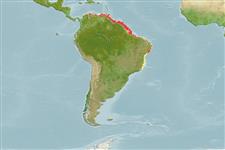Common names from other countries
>
Siluriformes (Catfishes) >
Ariidae (Sea catfishes) > Bagreinae
Etymology: Bagre: Mozarabic, bagre, taken from Greek, pagros = a fish (Dentex sp.) (Ref. 45335).
More on author: Linnaeus.
Issue
Junior synonym Felichthys filamentosu is a valid species according to Marceniuk et al., 2023 (Ref. 130933:433).
Environment: milieu / climate zone / depth range / distribution range
экология
морской; солоноватоводный демерсальный; пределы глубины ? - 50 m (Ref. 5217). Tropical; 12°N - 21°S, 77°W - 34°W
South America: Colombia to the mouth of the Amazon River.
Size / Вес / Возраст
Maturity: Lm ? range ? - ? cm
Max length : 55.0 cm TL самец/пол неопределен; (Ref. 5217); common length : 40.0 cm TL самец/пол неопределен; (Ref. 3265); наибольший вес (опубликованные данные): 975.00 g (Ref. 125970)
Two pairs of barbels on rostral region, one pair on lower jaw, one pair on posterior end of maxilla; end of maxilla barbel beyond anal fin origin; pectoral spine filament long, reaching anal fin origin; dorsal, pectoral, and pelvic fin membranes black; anal fin membrane black distally (some individuals white), white proximally; body silver gray or blue gray dorsally, silver white ventrally (Ref. 13608).
Chiefly marine, common around river mouths and also entering river estuaries. Feeds on small fishes and invertebrates, such as crustaceans. Marketed fresh.
Life cycle and mating behavior
Maturities | размножение | Spawnings | Egg(s) | Fecundities | личинки
Taylor, W.R. and N.A. Menezes, 1978. Ariidae. In W. Fischer (ed.) FAO species identification sheets for fishery purposes. West Atlantic (Fishing Area 31). volume 1. [pag. var.]. FAO, Rome. (Ref. 3265)
Статус Красного Списка МСОП (Ref. 130435)
CITES (Ref. 128078)
Not Evaluated
Угроза для людей
Traumatogenic (Ref. 36613)
Использование человеком
рыболовство: коммерческий
дополнительная информация
инструменты
Специальные отчеты
Скачать в формате XML
ресурсы в Интернет
Estimates based on models
Preferred temperature (Ref.
115969): 26.9 - 28.2, mean 27.5 (based on 116 cells).
Phylogenetic diversity index (Ref.
82804): PD
50 = 0.5625 [Uniqueness, from 0.5 = low to 2.0 = high].
Bayesian length-weight: a=0.00468 (0.00354 - 0.00619), b=3.08 (3.00 - 3.16), in cm Total Length, based on LWR estimates for this species (Ref.
93245).
Trophic level (Ref.
69278): 4.0 ±0.66 se; based on food items.
устойчивость к внешним воздействиям (Ref.
120179): низкий, минимальное время удвоения популяции 4.5-14 лет (Preliminary K or Fecundity.).
Prior r = 0.57, 95% CL = 0.37 - 0.85, Based on 4 data-limited stock assessments.
Fishing Vulnerability (Ref.
59153): Moderate vulnerability (42 of 100).
